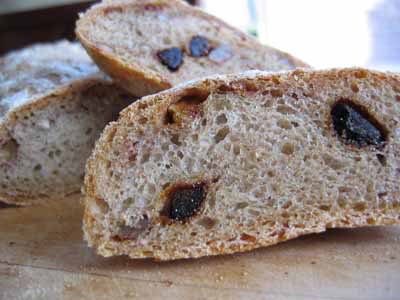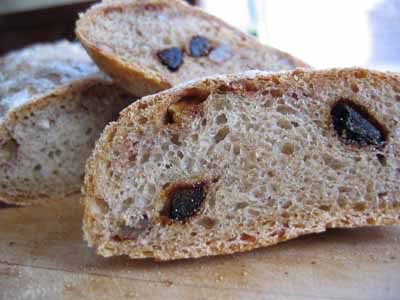
It’s been a really long time since I baked bread.
Years ago, when ICE was still Peter Kump, I took a three-week bread course there. We learned everything from utilitarian—though still flavorful—sandwich loaves like the Pullman to a gorgeous, golden semolina-raisin bread. My favorites, though, were the rustic, hand-formed ones we learned in our middle lesson: baguettes, rustic white bread, and the beautiful Italian bread ring. These allowed for maximum creativity, in my book; our instructor encouraged us to knead anything we wanted into our dough after the first rise—chopped rosemary and black olives for the Italian, dried cherries and chunks of bittersweet chocolate in the white, and my pick, dried figs and toasted pecans in the whole wheat.
In the years since I took that course, I’ve added several wonderful bread cookbooks to my collection: The Bread Baker’s Apprentice and Bread Alone
, not to mention all-purpose baking books like The King Arthur Flour Baker’s Companion
and Nick Malgieri’s How to Bake
, but for as much as I enjoy reading them, when I pull out the flour and the Kitchenaid, it’s my tattered, floury, scribbled-on Xeroxes from Kump that are pulled out with them. The recipes were originally Malgieri’s—he’s the director of their baking programs, so it’s sort of like having the best part of his cookbook at my fingertips.
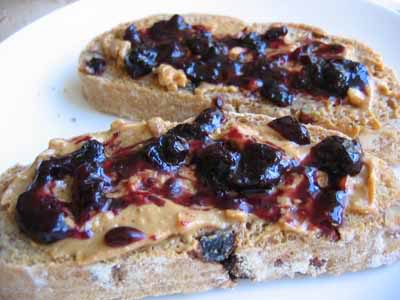
S and I topped slices of the fig-and-pecan bread with peanut butter and jelly for lunch today. I love this bread so much I keep eating it plain, but I’d be grateful for any suggestions for other things to top it with—I may play with some grated parmesan cheese, broiled in the toaster oven, next.
Rustic Part Whole Wheat Bread with Figs and Pecans
Inspired by Nick Malgieri
2 cups warm tap water, about 110 degrees
1 envelope active dry yeast [I use SAF Instant Yeast, a scant 2 t., instead]
3 ¼ to 3 ½ cups all-purpose flour
2 cups whole wheat flour
1 T. salt
Vegetable oil or nonstick cooking spray
½ cup each chopped figs & chopped toasted pecans
Additional flour for dusting the loaves
Cornmeal for dusting the pan
If you’re using dry yeast, sprinkle it on the water in a small bowl and let it stand two minutes before whisking, to proof it. If it doesn’t bubble up, your yeast is dead; start over with a new batch.
Put the smaller amount of white flour, all the whole wheat flour, and the salt in the bowl of your Kitchenaid, fitted with the dough hook. If you’re using SAF instant yeast, add it to the dry ingredients. Add water slowly (or water/yeast mixture, if you’re using the dry yeast) and mix on low speed to form a smooth, elastic, and slightly sticky dough, about 5 minutes. Incorporate the remaining flour a tablespoon at a time if the dough is too soft/sticky.

Place dough into an oiled bowl (you may need to use a scraper), and either turn dough over so top is oiled or spray top with cooking spray. Cover bowl with plastic wrap and allow dough to rise at room temperature until doubled. [I usually put it on top of the fridge, especially if the kitchen is cool—the slight heat works well.]

To shape loaves, scrape risen dough onto a lightly floured surface [my Roul’Pat Pastry Mat works beautifully here—I never have to add too much more flour, which keeps the dough from getting heavy]. Divide dough in half and shape one piece at a time. Press dough into a square, then roll it up tightly. Flatten this cylinder so that you have a surface to press the figs and pecans into, and then sprinkle half of them all over the dough. Roll the dough tightly, the long way, around the figs and pecans, and then roll up the dough again from a short end. Arrange dough seam side down, cover with plastic or a towel, and let it rest for 5 minutes. Repeat with remaining piece of dough.
Dust pan with cornmeal. Roll each piece of dough under palms of your hands to elongate it a little—keep your hands very lightly floured, since you’ll need some friction to make the dough spread. Work from the middle of the loaf outward, pointing the ends slightly. Place loaves seam side down on cookie sheet and dust heavily with flour, using about 1/3 cup in all. Cover with plastic or a towel and allow to rise until doubled.
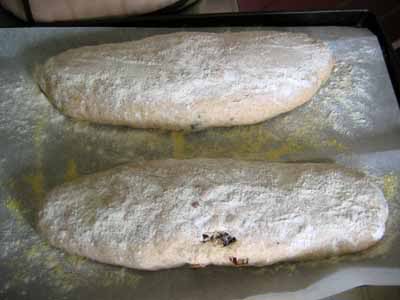
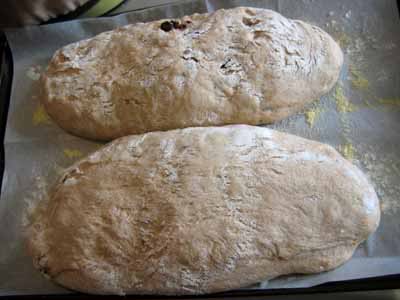
About 30 minutes before you intend to bake the loaves, preheat oven to 500 and set racks at middle and lowest levels. Set a rimmed pan on the lowest rack to absorb some of the excess bottom heat and keep the bottom of the loaves from burning.
Holding a razor blade or the point of a very sharp knife at a 30-degree angle, make a slash down the middle of each loaf from one pointed end to the other. Immediately place loaves in oven and carefully and quickly pour ½ cup of cold water into the pan you placed on the lower rack earlier—the steam will help form a good, crunchy crust. Lower temperature to 450 degrees.
After loaves have baked for 20 minutes and are completely risen, lower temperature to 350 and bake another 20 to 30 minutes longer, until bread reaches an internal temperature of 220 degrees. You may find that the outside of your loaves is already well browned before the inside reaches this temperature—if that’s the case, cover them with foil and continue baking.

Remove loaves from the oven, and cool on a wire rack.
